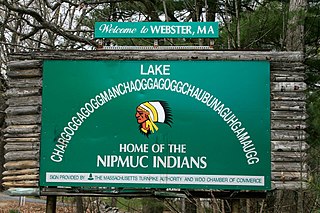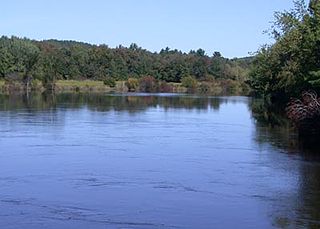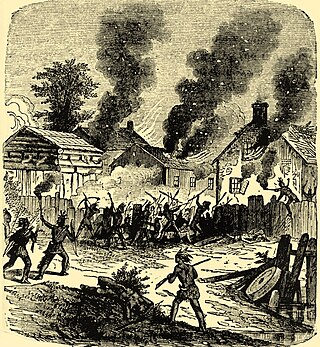Related Research Articles

King Philip's War was an armed conflict in 1675–1676 between a group of indigenous peoples of the Northeastern Woodlands and the English New England Colonies and their indigenous allies. The war is named for Metacomet, the Pokanoket chief and sachem of the Wampanoag who adopted the English name Philip because of the friendly relations between his father Massasoit and the Plymouth Colony. The war continued in the most northern reaches of New England until the signing of the Treaty of Casco Bay on April 12, 1678.
Praying Indian is a 17th-century term referring to Native Americans of New England, New York, Ontario, and Quebec who converted to Christianity either voluntarily or involuntarily. Many groups are referred to by the term, but it is more commonly used for tribes that were organized into villages. The villages were known as praying towns and were established by missionaries such as the Puritan leader John Eliot and Jesuit missionaries who established the St. Regis and Kahnawake and the missions among the Huron in western Ontario.

The Webster/Dudley Band of Chaubunagungamaug Nipmuck Indians, also known as the Chaubunagungamaug, Chaubunagungamaug Nipmuck, Pegan or Dudley/Webster Indians, is a cultural heritage group that claims descent from the Nipmuc people. They are a state-recognized tribe by the Commonwealth of Massachusetts.

The Chaubunagungamaug Reservation refers to the small parcel of land located in the town of Thompson, Connecticut, close to the border with the town of Webster, Massachusetts and within the bounds of Lake Chaubunagungamaug to the east and the French River to the west. The reservation is used by the descendants of the Nipmuck Indians of the previous reservation, c. 1682–1869, that existed in the same area, who now identify as the Webster/Dudley Band of the Chaubunagungamaug Nipmuck. Together with the Hassanamisco Nipmuc, both have received state recognition under the Massachusetts Commission on Indian Affairs.
The Pawtucket tribe were a confederation of Eastern Algonquian-speaking Native Americans in present-day northeastern Massachusetts and southeastern New Hampshire. They are mostly known in the historical record for their dealings with the early English colonists in the 17th century. Confusion exists about the proper endonym for this group who are variously referred to in European documents as Pawtucket, Naumkeag, Wamesit, or Mystic Indians, or by the name of their current sachem or sagamore.

The Nashaway were a tribe of Algonquian Indians inhabiting the upstream portions of the Nashua River valley in what is now the northern half of Worcester County, Massachusetts, mainly in the vicinity of Sterling, Lancaster and other towns near Mount Wachusett, as well as southern New Hampshire. The meaning of Nashaway is "river with a pebbled bottom".

Simon Willard (1605–1676) was an early Massachusetts fur trader, colonial militia leader, legislator, and judge.

Wheeler's Surprise, and the ensuing Siege of Brookfield, was a battle between Nipmuc Indians under Muttawmp, and the English colonists of the Massachusetts Bay Colony under the command of Thomas Wheeler and Captain Edward Hutchinson, in August 1675 during King Philip's War. The battle consisted of an initial ambush by the Nipmucs on Wheeler's unsuspecting party, followed by an attack on Brookfield, Massachusetts, and the consequent besieging of the remains of the colonial force. While the place where the siege part of the battle took place has always been known, the location of the initial ambush was a subject of extensive controversy among historians in the late nineteenth century.
Muttawmp was a sachem of the Nipmuc Indians in the mid-17th century, originally based in Quaboag. He participated in King Philip's War, taking part in most of the major engagements as one of the most important chiefs who fought for Metacomet.
Thomas Wheeler was a colonial soldier of the Massachusetts Bay Colony. In 1675 he took part in King Philip's War; later he wrote a narrative based on his experiences.

The Battle of Bloody Brook was fought on September 28, 1675 between an indigenous war party primarily composed of Pocumtuc warriors and other local indigenous people from the central Connecticut River valley, and the English colonial militia of the New England Confederation and their Mohegan allies during King Philip's War.

The Sudbury Fight was a battle of King Philip's War, fought in what is today Sudbury and Wayland, Massachusetts, when approximately five hundred Wampanoag, Nipmuc, and Narragansett Native Americans raided the frontier settlement of Sudbury in Massachusetts Bay Colony. Disparate companies of English militiamen from nearby settlements marched to the town's defense, two of which were drawn into Native ambushes and suffered heavy losses. The battle was the last major Native American victory in King Philip's War before their final defeat in southern New England in August 1676.

The Lancaster Raid was the first in a series of five planned raids on English colonial towns during the winter of 1675-1676 as part of King Philip's War. Metacom, known by English colonists as King Philip, was a Wampanoag sachem who led and organized Wampanoag warriors during the war. Teaming up with Nipmuc and Narragansett warriors, the Wampanoag successfully raided the town of Lancaster, securing provisions and prisoners to help them carry on into their winter offensive.
The Northeast Coast campaign of 1676 took place during King Philip's War. It involved the Wabanaki Confederacy raiding colonial American settlements along the New England Colonies/Acadia border in present-day Maine. In the first month, they laid waste to 15 leagues of the coast east of Casco. They killed and captured colonists and burned many farms, blunting the tide of colonial American expansion. The campaign led colonists to abandon the region and retreat to Salem, Massachusetts. The campaign is most notable for Richard Waldron entering the war, the death of Chief Mog, and the attack on the Mi’kmaq that initiated their involvement in the war.

Tantamous was a well-known Native American Nipmuc leader in seventeenth century Massachusetts. Tantamous was a powwow who lived near the Assabet River, later in Nobscot. Tantamous "...may have gotten his English name for his good advice."
Peter Jethro was an early Native American (Nipmuc) scribe, translator, minister, land proprietor, and Praying Indian affiliated for a period with John Eliot in the praying town of Natick, Massachusetts.

Daniel Takawambait was likely the first ordained Native American Christian pastor in North America, and served the church in the praying town of Natick, Massachusetts from 1683 to 1716. Takawambait also advocated for indigenous land rights in colonial Massachusetts, and authored at least one publication.

Quaiapen was a Narragansett-Niantic female sachem (saunkskwa) who was the last sachem captured or killed during King Philip’s War.
Pumham was one of Metacomet's chief advisors during King Phillip's War. He was sachem of Shawomet. He was described as "one of the stoutest and most valiant sachems that belonged to the Narragansett." He was friends with English settlers, but aligned himself with Metacomet when war broke out.
The Praying Indians of Natick were a community of Indigenous Christian converts, known as Praying Indians, in the town of Natick, Massachusetts, one of many Praying Towns. They were also known as Natick Indians.
References
- 1 2 3 4 Drake, pg. 79
- 1 2 Hanson, Robert Brand (1976). Dedham, Massachusetts, 1635-1890. Dedham Historical Society. pp. 89–90.
- 1 2 Bonfanti, pg. 26
- ↑ Bonfanti, pg. 27
- ↑ Diary of Samuel Sewall, entries July 17, 1676 and Sept. 26, 1676 , p 15, 22 (accessible on google books)
- ↑ Rev. Thomas Cobbett, of Ipswich, "A Narrative of New England's Deliverances," (written in 1677 to Increase Mather) New England Historical Genealogical Register, (Volume 7, 1853), p. 209 https://www.familysearch.org/wiki/en/New_England_Historical_Genealogical_Register_Online
- ↑ Samuel Gardner Drake, Indian Biography, p. 137 accessible on google books
- ↑ Moynihan, pg. 28
- ↑ Schultz and Tougias, pg. 69
- ↑ Cogley, pg. 161
7. p. 462